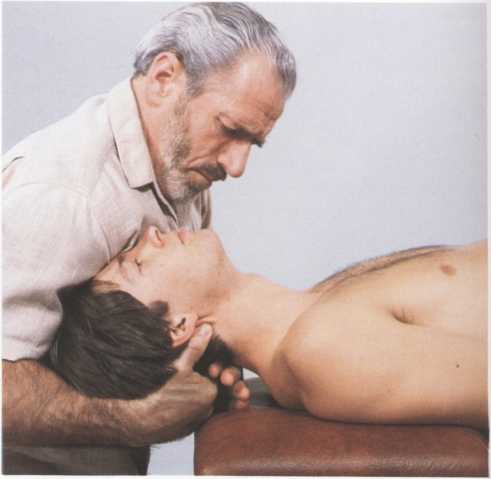48 (390)


3.5.2C. Specific technique to increase dorsal flexion of the occiput on the atlas.
P supine.
Starting Position: P: Supine; head beyond couch end with the atlas positioned at couch edge. T: Standing at head of couch.
Grip: T’s right hand grips P’s occiput, thumb stabilizing the ventral aspect of the right trans-verse process of P's atlas, and wrist and forearm supporting P’s head. Ts right shoulder presses against P’s forehead, without pressing on P’s nose or eyes. (If P finds this grip uncomfortable, a smali cushion may be placed between T’s right shoulder and P's forehead). T’s left hand rests on the couch under P’s neck, thumb stabilizing the ventral aspect of the left transverse process of P’s atlas.
Procedurę: Using this grip, T applies traction, and then maintaining this traction, moves his/her body (see Notes) to gradually and fully dorsally flex P’s occiput on the atlas. T’s thumbs stabilize P’s atlas to prevent it from following the ventral movement of the occipital condyles.
Stimulation of Antagonists: T retains grip, and asks P to look upwards, thrust chin out, and dorsally flex in the direction just stretched. T resists that movement to stimulate P’s antagonists.
Notes: This procedurę is most easily performed if T starts with slight knee 11ex, and then “sinks,” bending knees morę to induce the desired dorsal flexion.
T may also control knee flex to supply or vary resistance in the Stimulation of Antagonists phase.
T may find traction morę easily applied with P sitting, see the preceding two techniąues, 3.5.2A and 3.5.2B, pp. 46 and 47.


Fig. 32 a. Starting Position.

Fig. 32 b. Finał Position.
48
Wyszukiwarka
Podobne podstrony:
49 (372) 3.5.3A. Specific techniąue to increase dorsal flexion of the atlas on the axis. P. sitting.
50 (351) 3.5.3B. Specific techniąue to increase dorsal flexion of the atlas on the axis. P sitting.
51 (336) 3.5.3C. Specific techniąue to increase dorsal flexion of the atlas on the axis. P supine. S
46 (412) 3.5.2A. Specific technique to increase dorsal flexion of the occiput on the atlas. P sittin
47 (396) 3.5.2B. Specific techniąue to increase dorsal flexion of the occiput on the atlas. P sittin
62 (263) 3.6.2C. Specific techniąue to increase dorsal flexion with rotation and lateral flex-ion to
58 (289) 3.6.1A. Non-specific techniąue to increase dorsal flexion with rotation and later-al flexio
60 (278) 3.6.2A. Specific technique to increase dorsal flexion with rotation and lateral flex-ion to
61 (265) 3.6.2B. Specific techniąue to increase dorsal flexion with rotation and lateral flex-ion to
63 (253) 3.6.2D. Specific technique to increase dorsal flexion with rotation and lateral flex-ion to
64 (250) 3.7.1A. Non-specific technique to increase dorsal flexion with rotation to the right a
65 (245) 3.7.IB. Non-specific techniąue to increase dorsal flexion with rotation to the right a
66 (237) 3.7.1C. Non-specific techniąue to increase dorsal flexion with rotation to the right a
67 (234) 3.7.2A1. Specific technique to increase dorsal flexion with rotation to the right and
68 (230) 3.7.2A2. Specific techniąue to increase dorsal flexion with rotation to the right and
69 (224) 3.7.2B. Specific techniąue to increase dorsal flexion with rotation to the right and l
70 (226) 3.7.2C. Specific techniąue to łncrease dorsal flexion with rotation to the right and l
71 (223) 3.7.2D. Specific techniąue to increase dorsal flexion with rotation to the right and l
45 (421) 3.5.1. Non-specific techniąue to increase dorsal flexion. P supine. Starting Position: P: S
więcej podobnych podstron